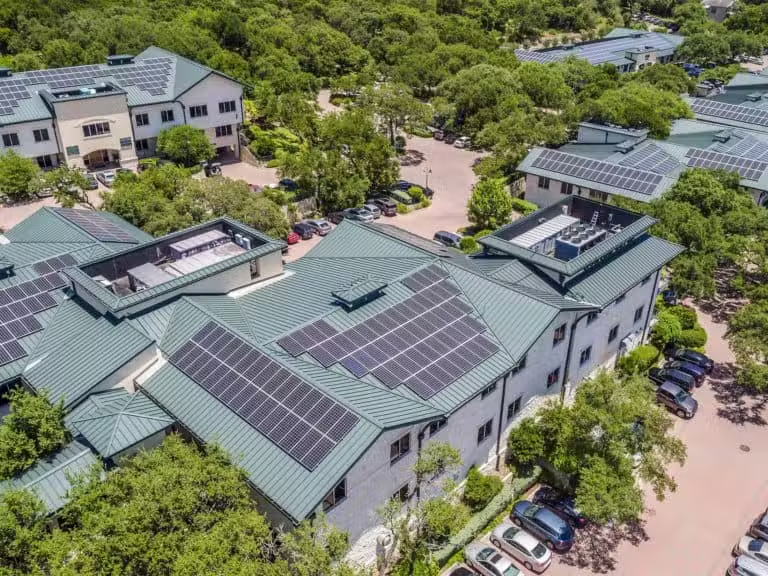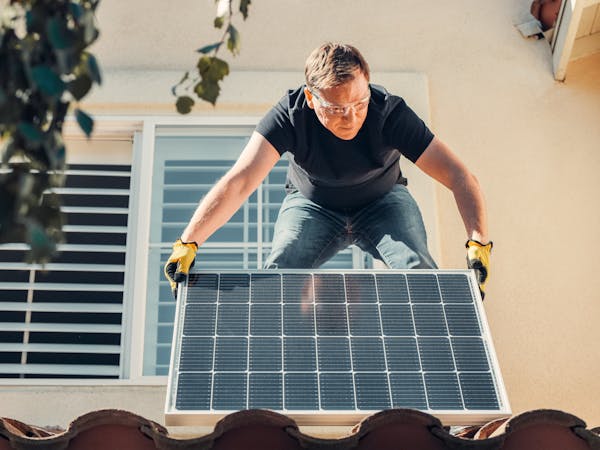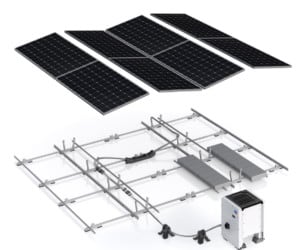COMMERCIAL SOLAR PANEL COST AND PRICING
Commercial solar panel costs have dropped significantly over the past decade. According to NREL, the cost of commercial solar in the U.S. has declined by two-thirds since 2010, primarily driven by more efficient solar technology and lower inverter costs. In Texas, the average cost of commercial solar panels is 7.6% lower than the national average.


Average Installed Cost of Commercial Solar Panels
Solar is often thought about in terms of the price per watt of power capacity, which equalizes system costs similar to the price-per-square-foot metric the in real estate sector. The average installed cost of solar for commercial purposes is $2.00 per watt. A 100 kilowatt (kW) commercial solar system will produce about 136,000 kilowatt-hours (kWh) per year, enough to offset the full electricity bill for an average commercial customer in Texas, and would cost approximately $200,000 before applying federal, state, and local incentives.
Each commercial installation and system is different. So, the best way to find out how much solar would cost at your location is to request a free site analysis. We will assess the feasibility and the ROI of commercial solar panels for your business.
Commercial Solar Panels Cost Breakdown
The first question we get from every customer is, “how much do commercial solar panels cost?” The answer, of course, is that it depends on the size of the system, type of equipment, and your electricity usage. There are many factors that determine the cost of commercial solar panels for businesses.
- Size of the system. A small boutique shop and a shipping warehouse are going to have very different needs in terms of their energy supply, which is why the size of your solar array will be one of the largest factors in your installation cost.
- Type of equipment. Those rooftop black panels you see aren’t all the same. We offer three unique types of solar panel technologies: monocrystalline, polycrystalline, and thin film. The material makeup of each of these affects their efficiency, cost, and overall aesthetic. Our team is happy to help you choose the best type of solar panel to fit the needs of your business.
- Your electricity usage. This goes back again to the size of your business, since a larger facility will have increased energy needs. However, your location also dictates the electricity rates in your area. The national average is about 11 cents per kilowatt-hour, according to 2019 data from the U.S. Energy Information Administration.

System Size
The size of your system will be determined by your available roof space, electricity usage, and financial goals. As systems scale to larger sizes with more panels, the overall cost of your system will increase primarily due to the following:
- How Many Solar Panels Do You Need? The larger your facility — and therefore, your total energy needs — the more solar panels you will require. You can calculate how many you’ll need by multiplying your business’s hourly energy requirement by the peak sunlight hours for your region and dividing that by a panel’s wattage.
- What Type Of Mounting Infrastructure Does Your Installation Require? There are several types of solar mounting options, as well as cabling, and the cost of this equipment will also affect the overall cost of your installation.
- What Percentage of your Energy Use do you Want to Come from Solar? You’ll need to decide if going solar for your business means simply reducing your dependency on the power grid or using solar as your main source of electricity. If it’s the latter, you’ll also want to consider solar batteries to ensure power during downtime or emergencies.
- How Energy Efficient is Your Current Building/Organization? Every business needs to be able to rely on a consistent energy supply. At the same time, every electrical device demands its own unique share of energy — from lighting to HVAC to machinery or electricity-powered equipment. That’s why the energy efficiency of your building matters, especially if you plan to use solar energy as your single source of electricity.
WANT TO KNOW MORE?
Begin a FREE Consultation.
- Send us your info.
- We’ll contact you to schedule an appointment.
- An energy consultant will meet with you at your home, place of business or virtually.
- You will get a custom proposal with system size, design, costs, financing, and savings.
Type of Equipment
The commercial solar application you choose will also affect the overall cost, even if the same solar panels are used. The equipment used to attach solar panels to a standing seam metal roof is different than a ballasted system on a flat roof. Solar carports and ground mount systems also require an additional structure and typically require cabling to run underground back to the electric meter. Each of these applications have costs that vary based on the type of components required for the system.
Rail mounting includes many more parts (including the railing itself and all associated bonding attachment). The price is higher here not only for the extra equipment, but for the extra labor it requires. In fact, the overall cost of a rail-mounted system can be almost double the cost of a direct attach (rail-less) system. The type of system you choose for your business will also affect the cost. Options include:
- Rooftop Solar. This is the most commonly used type of solar setup because businesses can utilize their unused roof space to mount the installation. There are a few different types of roof mount systems, including:
- Standard roof mount: This type of installation uses a fully-anchored, rail-based mounting style. This secure attachment makes it ideal for pitched roofs and uniquely shaped roofs.
- Single-tilt flat roof mount: This installation type works best for large, flat roofs, such as a manufacturing facility or warehouse.
- Dual-tilt flat roof mount: The dual-tilt racking is similar to the single-tilt except that its panels face in both directions, which means double the amount of panels in the same amount of space as a single-tilt roof mount. This design makes it ideal for businesses with roofs that are flat but small, as it makes the most of limited space.
- Carport solar. If your business lacks the space necessary for rooftop solar, a large on-site parking lot can accommodate your installation. There are a few types of carport solar, including:
- Long span canopy: This installation covers two parallel rows of parking, as well as the inside driving lane, with one continuous canopy.
- Dual-tilt canopy: A dual-tilt installation covers just one row of parking, with two sets of panels tilting down toward the middle.
- Garage-top canopy: If your business has an on-site parking garage, a garage-top canopy will be an ideal installation. It easily adapts to various structural conditions while also maintaining optimal direction for peak performance.
- Ground-mount solutions. Businesses with large-scale needs may do best with larger installations, such as power-plant level production solar setups. This type of installation utilities a standard ground mount modular racking system to mount the modules at a tilt.
Rebates, Tax Credits, and Other Incentives
Aside from the cost of the equipment and installation, there are government programs and state incentives that can lower the cost of commercial solar panels for your business, including:
- Investment Tax Credit (ITC). In 2021, the government-issued solar investment tax credit (ITC) allows businesses to deduct 26% of the cost of an installation from their annual taxes. This amount will drop to 22% in 2023 and 10% in 2024.
- Local Incentives. In an effort to help more businesses go solar, most cities offer rebates to make installation more affordable. For example, Austin Energy offers a flat $2,500 post-installation rebate for customers who go solar. In order to receive the rebate, customers must take a training course and hire an Austin Energy approved contractor.
- Utility Rebates. Utility providers also offer financial incentives for business owners who choose to install solar, including distributed generation rebates for on-site solar PV systems. These utilities include Garland Power and Light in Texas, Holy Cross Energy in Colorado, and many more.
- Net Metering. This incentive allows businesses to send their unused energy to the grid in exchange for credits on their monthly utility bill. Texas and Colorado both have net metering in place all over the state through local utility companies.
- Sales Tax Incentives. Sales tax incentives offer an exemption from the state sales tax (or sales and use tax) for the purchase of a solar panel system. Colorado and Texas both offer this exemption so that business owners won’t pay extra taxes as a result of the value that their solar panels add.
The average commercial solar panel costs about $2.00 per watt, but this is before local solar rebates and incentives go into effect. A commercial customer will pay an average net cost of $200,000 for a commercial solar panel system.
A 1,000 kW (equivalent to 1 MW) solar panel system will cost you at least $1 million, typically around $1.15 million. The most accurate pricing will depend on how much energy your business requires, which will determine how many commercial panels you need to power it. Because they’re larger, commercial solar panels produce more kW per hour than residential solar panels.
The average net price of a commercial solar system is $200,000. This cost could be more or less depending on the size of your building, how much energy you use, the efficiency of your panels, the cost of solar in your region and local electricity rates. Compared to residential solar panels, commercial panels are more expensive because they’re larger and usually more are needed.
The efficiency of your commercial solar panels depends on their make and model. SunPower offers the most efficient solar panels on the market. Design My Solar partners with SunPower to provide its customers with the best solar panels in terms of efficiency, durability, warranty, aesthetic and more.
The benefits of commercial solar panels are similar to those of residential panels. These benefits include healthier air quality from reduced carbon emissions, lower monthly energy bills, energy independence from the electric grid, and freedom from your utility’s unpredictable energy costs that often scale high. More and more companies are motivated to go solar for environmental, social, and governance (ESG) reasons, employee retention and customer loyalty.
Yes, solar panels work on commercial buildings. Commercial buildings benefit from solar panels in the same way that residential properties do. However, commercial solar panels are different from residential panels in that they’re much bigger and cover larger property sizes.
Yes, solar panels work on commercial buildings. Commercial buildings benefit from solar panels in the same way that residential properties do. However, commercial solar panels are different from residential panels in that they’re much bigger and cover larger property sizes.
Solar panels have an average life span of 25 to 30 years. Depending on how well you care for your panels with periodic maintenance such as cleaning and inspections, they will likely last longer. However, their solar panel efficiency decreases by about 0.8% each year, which affects the amount of energy you can routinely generate.
SunPower solar panels are the most efficient solar panels on the market. Its A-Series panel has a maximum-rated efficiency of 22.8% and is ideal for home installations. Design My Solar exclusively provides SunPower panels to ensure our customers have the best all-around system.
Solar energy is useful for buildings because it helps them gain energy independence while stabilizing high energy bills. Commercial buildings have very high operating costs, but solar panels help save money because they eventually pay for themselves and put money back into a business’s pockets.
The three types of solar systems include grid tied, off-grid and hybrid panels. Each system has unique pros and cons. Grid tied systems are always connected to the local electric grid, and off grid systems are completely independent from the grid. Hybrid systems are in between, meaning they’ll connect to the grid if the panels don’t produce enough energy to fully power a building.